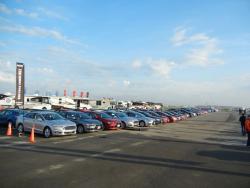 AJAC 2013 CCOTY TestFest Cars ready for testing. Click image to enlarge |
Photo Gallery:
2013 Canadian Car of the Year Testfest
Another successful installment of the annual Automobile Journalist Association of Canada’s (AJAC) TestFest has come and gone and in the end, 11 category winners were announced. For those unfamiliar with the AJAC Canadian Car of the Year Award (CCOTY) process, the whole system may seem a bit confusing and every year several questions are asked regarding it. We at Autos.ca are here to help explain the process and will feature a series of articles to help consumers learn what exactly goes into deciding the Canadian Car of the Year. Already, Senior Editor Jonathan Yarkony described what it is like to be a part of the testing process, and then described it some more, and in the coming week, we will post articles on how the CCOTY scoring system works and why the CCOTY is important to Canadian consumers, manufacturers, and the auto industry. But for now, we will dive into each of the eleven CCOTY categories and discuss the highlights, the low lights, and ultimately, help provide some insight into why the winners did just that—win. Today we will focus on the ‘everyday’ vehicles—the small cars, family cars, and CUV/SUVs.
CITY CAR, by Mike Schlee
In a category of only two vehicles, there has to be a winner and a loser. Or, if you are more optimistic, both cars were guaranteed at least second place. This class was almost decided before it started as what we had here was one electric car, and one electric pod. Ok, that may not be fair to the i-MiEV, but many still do not get its futuristic styling, bare-bones interior and unusual driving traits. The Focus EV beat the i-MiEV in every category but visibility, range and price. The reason is that the Focus EV drives just like a regular Focus, an already well-built compact. Well, “just like” may be a stretch.
The Focus EV silently whooshes down the road and produces gobs of on-throttle front-wheel spin thanks to its low-rolling-resistance tires. All that wheel spin does lead to a nearly five-second advantage to 100 km/h from a standstill for the Focus EV. The i-MiEV was airier inside and can better accommodate rear passengers, albeit in less comfort. In the end, though, the Focus EV, even with its much higher price tag and limited range was still more than enough ‘car’ to hold off the i-MiEV. In layman’s terms, it isn’t full of compromises for an EV, it looks like a regular car and although it has a limited range, all EVs do.











